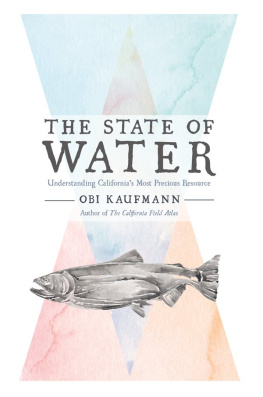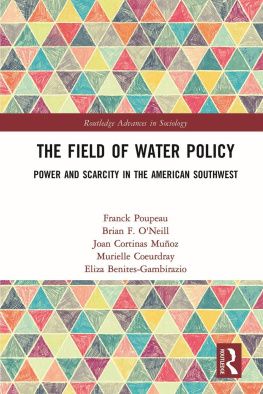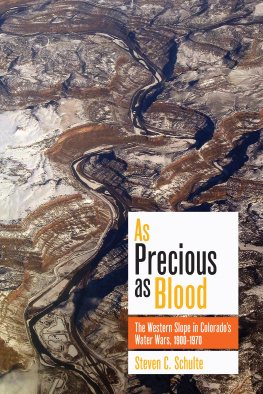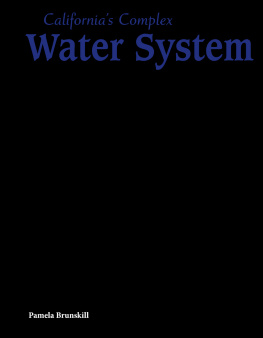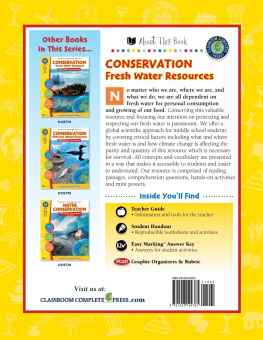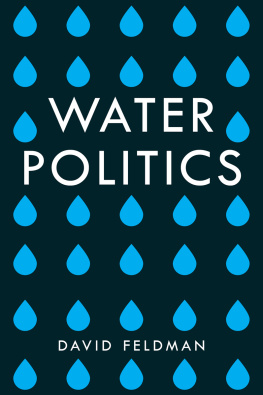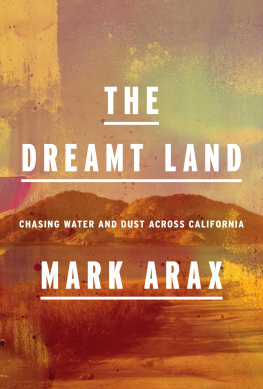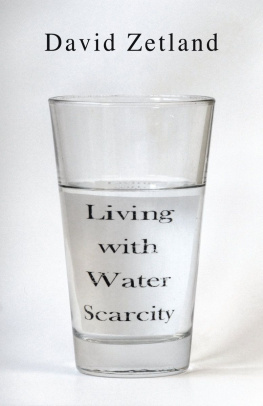Contents
Guide


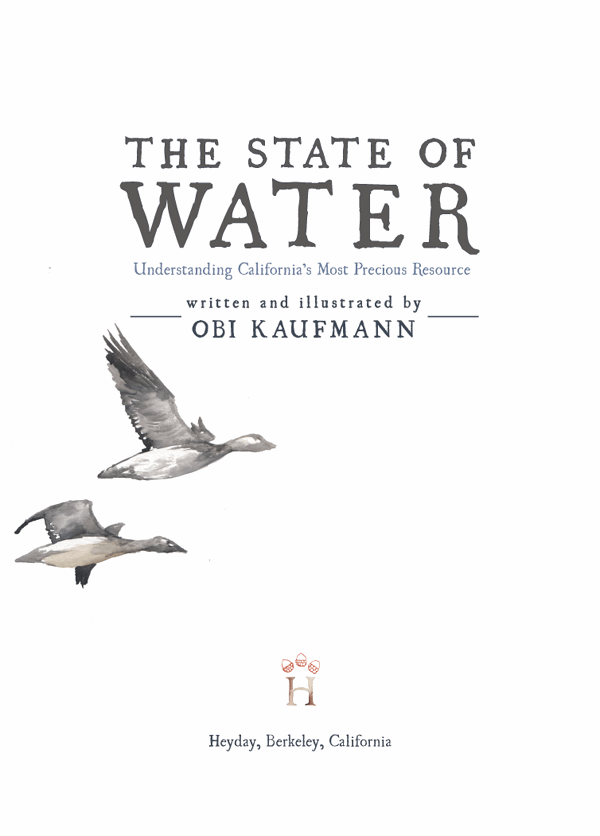
Copyright 2019 by William Kaufmann
All rights reserved. No portion of this work may be reproduced or transmitted in any form or by any means, electronic or mechanical, including photocopying and recording, or by any information storage or retrieval system, without permission in writing from Heyday.
Library of Congress Cataloging-in-Publication Data
Names: Kaufmann, Obi, author.
Title: The state of water : understanding Californias most precious resource / Obi Kaufmann.
Description: Berkeley, California : Heyday, 2019. | Includes bibliographical references.
Identifiers: LCCN 2018047383 (print) | LCCN 2018060603 (ebook) | ISBN 9781597144766 (E-book) | ISBN 9781597144698 (pbk.)
Subjects: LCSH: Water-supply--California. | Water use--California. | Water conservation--California. | Water resources development--California.
Classification: LCC TD224.C3 (ebook) | LCC TD224.C3 K353 2019 (print) | DDC 333.91009794--dc23
LC record available at https://lccn.loc.gov/2018047383
Cover Design: Ashley Ingram
Interior Design: Obi Kaufmann and Ashley Ingram
Published by Heyday
P.O. Box 9145, Berkeley, California 94709
(510) 549-3564
www.heydaybooks.com
10 9 8 7 6 5 4 3 2 1
To all the children in my family:
Sophia, Finn, Olive, Zoe, Owen, Austin,
Vander, Olivia, Ruby, and Emilia
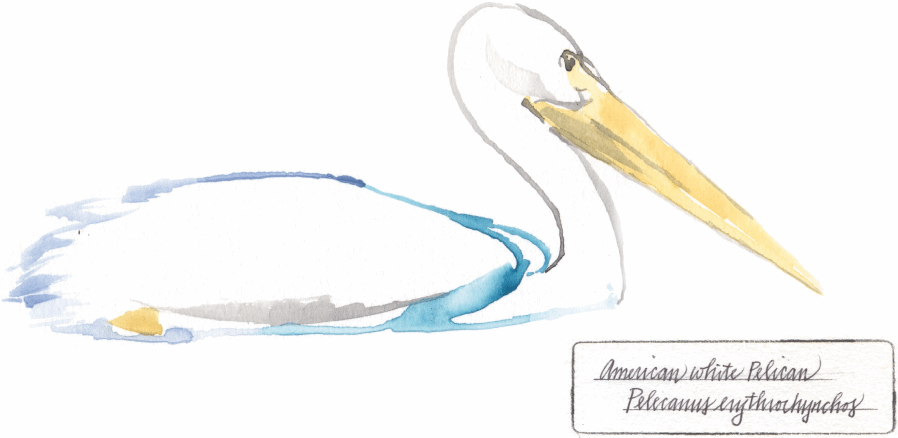
We dont govern water. Water governs us.
Kalahari proverb

We carry into our future at least as many responsibilities as we do rights.
This is our charge.
We have the right to extract, but we have the responsibility to replenish.
We have the right to develop, but we have the responsibility to restore.
We have the right to inhabit, but we have the responsibility to set aside.
Stewardship is the active management of leaving the more-than-human world to its own functioning devices.
CONTENTS
Map 01.01 Water Yesterday, Water Today, Water Tomorrow
An overview of the state of water
Map 01.02 The Wild California Riverscape
The living circuit in the body of California
Map 01.03 Californias Water Projects
The geography of the California water machine
Map 02.01 Salmon and the Sacramento
A measure of health in Californias natural world
Map 02.02 Restoration of the San Joaquin
Mapping decisions of the valleys past and future legacy
Map 02.03 Emancipation of the Klamath
The largest dam removal in American history
Map 03.01 Replenishment of the Salton Sea
Tracking solutions for Californias number-one mess
Map 03.02 Allocations on the Colorado
The denouement of the American Nile
Map 04.01 Hetch Hetchy Revisited
The bravest of all opportunities
INTRODUCTION
01.a The State of Water
Most of California, especially the parts where most of the people live, is truly arid. Water is life, and the idea that there is not enough of it to go around is potentially the most divisive splintering agent to this or any society whose environment cannot support agriculture without irrigation. It is not just that water security, as an abstract yet all-encompassing priority, is or is not capable of dividing or of ripping apart communities in California on whatever scale, but it is the willingness of political and business entities to exploit that potential that represents the largest threat to our unity and civility.
Unity is at the core of my presentation. There is only one California to serve. If this book carries a political agenda, it is to point out our agreements over our differences. Water culture in California is built as much on tradition as it is on infrastructure. Deconstructing that tradition is not in the scope of this presentation. The disposition of this book is pragmatic, not idealistic. I assume that the answers to the dilemmas that concern uswater security for all, our climate future, preserving our biodiversity, and honoring our history of agriculture and the culture that it supportsare not only out there, but easier, or at least less painful than we might suppose. The job of this book is to examine and present the large water systems of California, and to further argue the case for water conservation, as it is the official policy of the state. But this is not a book on public policy. I dont spend too much time talking about groundwater, as my main scope of interest is surface water and how systems of rivers and aqueducts impact habitat for wildlife. My bias is to surface water solutions and systems, as that is my focus as a naturalist, a painter, and a lover of the natural world of California.
This book is a cursory survey, a thumbnail view of the ecological reality of our water future by examining the systems of our water past. It is a tall order and I am happy to wade out into the contentious flood. I dont dwell on speculative or emerging technological solutions for water use. I also dont delve too much into water rights and seniority. This is not a work of history. Despite its dependence on data-driven maps and statistics, this is as much a work of philosophy as it is a work of systems thinking in the context of California water. In writing this book, I serve you, my community, and thereby myself in a calm circle of understanding. Im not banging my fist on the table. Those days are done.
This is not a work of pure geographic literacy. I am not pretending to describe this incredibly complex system dispassionately; in fact it doesnt even interest me to do so. If I were interested in a purely scientific vision, void of passion and perspectivein just another California water study (and plenty of them do already exist)I would have chosen a different profession. Alas, I am the same artist-naturalist that painted the California Field Atlas and I maintain that my visiona vision that always begins with data-driven inspirationis human, biased, nuanced, and at times messy. I let a flowery language of poetry infiltrate this book on many levels.
This book is a specific kind of examination into the California waterscape. It is an account of my own journey to understand it and the way it serves and perhaps doesnt serve us and the natural world, now and going into the future. I take exceptional license, always, and have shielded myself by calling my work the work of an artist. Although this work resembles a piece of journalism or maybe even a submission of scientific merit, it is neither. I am a naturalist (a student of natural history) and I present this work as a journal of my investigation, weighted and probably even encumbered by and with my perspective.


